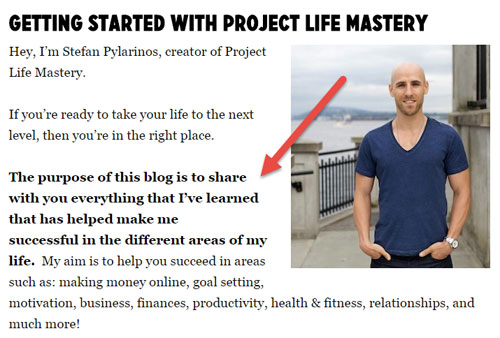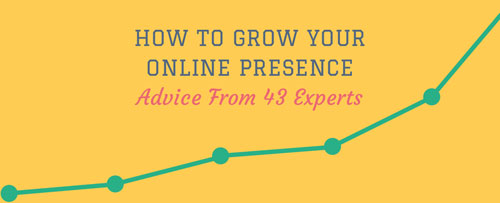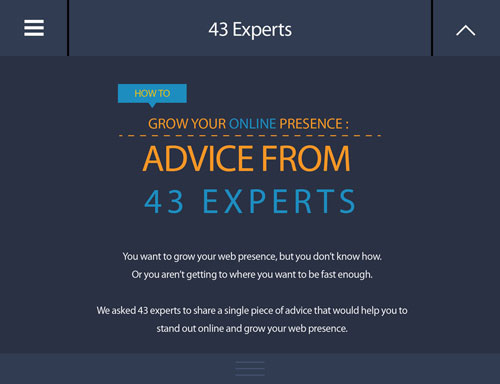How To Boost Engagement On Your Blog (So It Doesn’t Look Like Like A Ghost Town)

Does your blog look like a ghost town?
You put so much effort into writing great content, and it deserves more engagement.
So how can you encourage your readers to engage with you?
It could be in the form of blog comments, mentions on social networks, mentions on other blogs or something else.
You can make it happen and in this post I’ll show you how.
Let’s dive in…
#1 – Understand your audience and how you can help them
Your audience is the foundation of your blog, they are the reason it exists.
So it makes sense that you would need to understand exactly who they are, what they need help with and exactly how your blog can help them.
On a basic level, it’s essential to be able to answer this question:
My blog helps ____ who ________.
So an example for a B2B blog might be:
My blog helps small businesses who want to get more clients.
Once you’ve answered this question you can move on to creating personas for your target audience.
A persona is just a profile of your ideal reader where you’ll answer other questions covering demographic information, goals, challenges and more.
Note: You can target a broad audience overall, but it’s worth crafting content for different sub-groups within that target audience. For example, if you run a marketing blog you could craft specific content to target freelance marketers, agency marketers and in-house marketers separately.
What if you don’t have enough information on your target audience?
There a few ways you can get some awesome information to help you.
Analytics tools like Google Analytics and Clicky are a good place to start for quantitative data but you’ll glean the best insights from qualitative sources such as survey’s and polls.
Typeform.com is a great solution for this. Allowing you to create surveys for free which you can send to your email subscribers and/or social media followers.
Another good option is to find a forum or online community where your target audience hang out. You can search through posts to find exactly what people need help with. And there’s a good chance you’ll get a bunch of great content ideas too.
Does your audience know how you can help them?
When someone visits your blog and reads your about or start here page, they need to easily identify how you can help them.
Here’s a great example from Stefan Pylarinos:

Immediately, anyone reading that page knows how Stefan’s blog can help them.
#2 – Create a blog your readers will want to come back to
User experience is everything and if you want people to come back to your blog, improving that experience is extremely important.
Here are some tips to consider:
- Deliver a clear message on why your blog exists and how it can help people.
- Consider removing any badges/widgets that don’t help you or your readers.
- Consider removing any advertisements that aren’t performing (this depends on how you earn money from your blog).
- Simplify your navigation and move less important links to your footer.
- Fix broken links but avoid using a WordPress plugin. An external tool like SEO PowerSuite’s Website Auditor would be best.
- Update old content to maximize your traffic.
- Improve page load times on your blog using an optimization platform like NitroPack or one of these WordPress optimization plugins.
#3 – Publish content that is so good people want to tell the world
You’re already publishing great content, but how can you improve things further? How can you make content that is so good that people can’t help but tell the word about it?
This does mean investing more time into crafting blog posts but the benefits of doing so are awesome.
And it’s these types of “pillar” posts that form the foundations for a lot of blogs.
Why?
Aside from more engagement, they also generate more traffic and earned links providing you put the time into promoting them effectively.
There are plenty of ways you can approach these pillar type posts:
- Cover a topic in more detail than other posts on the web
- Use of unique imagery
- Create a unique design/layout for the post
- Add a table of contents to improve navigation
- Add a level of interactivity such as filtering options for list posts
#4 – Write the right headlines
Headlines can make or break the success of your content so it’s no surprise that the web is full of tips that can help you out here.
But before you consider using any of the advice you’ll find online, it’s important to remember that your headline is a promise and your content must deliver.
Why?
If your content doesn’t deliver on the promise your headline makes, sure, you may get plenty of traffic but chances are you’ll have the wrong traffic. And it’ll annoy people – never a good first impression to make!
If you need help with headlines, be sure to check out our guide to writing better blog post headlines or our article on headline writing tools.
#5 – Mention other bloggers in your content
I’ve talked a lot about mentioning other bloggers in your content before and it works.
The results can include more traffic, engagement and the foundation of a relationship with other bloggers – it’s those relationships that will pay dividends in the future.
But if you are going to use this tip, it’s worth mentioning a few pointers:
- Don’t mention other bloggers for the sake of it – If mentioning someone won’t help your audience, then don’t mention them. If mentioning them backs up your point or provides a great example, go for it!
- Let bloggers know when you’ve mentioned them – The important thing here is to avoid pushing people to leave a comment or share your comment. Just give them a heads up and let them know why you mentioned them.
#6 – Write about newsworthy topics and be the first to jump on trends
Looking out for trends and being the first to write about them is a great way to grow your audience and increase engagement at the same time.
Reading larger publications in your industry can be a great way of spotting these trends; you can then publish a post as a response.
Ann Smarty wrote a great guide on how to monitor and write newsworthy content, well worth reading.
#7 – Publish content as often as your audience can consume it
When you are looking to encourage engagement and get more comments from your readers, post frequency is an important factor.
If you publish too frequently, some of your readers won’t be able to keep up so the average number of comments you receive may drop.
Content length comes into effect here too, because when you publish longer content, it takes more time for people to read.
It comes down to finding a balance between content length and content frequency. And it will likely vary from niche to niche so it’s worth experimenting with this to find the perfect balance – there is no perfect answer here.
#8 – Publish different types of content
There is a lot more that you can publish other than straight up blog posts.
This includes:
- Video
- Podcasts
- Infographics
- Interview
- Group interviews
When publishing different content types you can expand the reach of your blog and tap into an audience that you wouldn’t have had access to previously. For example, some people prefer podcasts to written content.
I’ve had a lot of success with group interviews in the past, they’re time consuming to put together but the fact that a lot of other people are involved in the content creation process is a great catalyst for engagement.
My group interview on how to build an online presence had over 5,000 visitors in a few days and ended up receiving 2,100 social shares. There were a good amount of comments and some great mentions on other sites.

The post was turned into an infographic and published on TweakYourBiz.com where it received another 2,000+ shares and over 32,000 visits.

Just by varying the content you publish, you can get some great results but when you repurpose that content into other types, you can take engagement and visibility to new heights.
#9 – Offer your readers something helpful for free
For a lot of blogs, around 75% of visitors will never return.
So what can we do about this?
The most effective solution is to offer a free download in exchange for joining your email list.
By doing this you’ll be able to send updates on your new content to people who may not have subscribed otherwise.
The free download you offer could be an ebook, template, checklist, discount code or something else. Exactly what you choose will entirely depend on your blog, your offering and your niche.
For more information on building an email list, check out my ultimate guide.
#10 – Ask questions
Sometimes all it takes to boost engagement is to ask a question.
You could ask questions in the emails you send to your subscribers or you could ask questions at the end of blog posts.
Where and when you choose to ask questions depends entirely on what your goal is with your content.
For example, on some posts you may prefer to not ask a question and encourage your readers to take action on a particular piece of advice instead.
#11 – Respond to comments
More and more bloggers are opting to remove comments. I removed them but that doesn’t mean you should remove them.
Comments make a lot of sense for new bloggers in particular but they get more difficult to manage as your blog grows.
Regardless, if you have comments enabled, you can encourage more engagement by responding to them.
It can help you get to know your readers better and start building a more meaningful connection with them. You’ll likely get some helpful feedback too.
How manageable this is will depend on the number of comments you receive. Sure, you may not be able to respond to them all but it’s worth trying to respond to as many as possible.
#12 – Comment on other blogs in your niche
A big part of engagement is networking and building relationships with other bloggers.
And one of the best ways to do this is to leave helpful comments on other blogs in your niche, particularly those where the author responds to comments.
#13 – Build a presence on forums and communities where your audience hangs out
If you want to build an online presence, you need to be present, particularly in the communities, forums and social networks where your target audience hangs out.
This may include the likes of:
- Niche forums
- Facebook groups
- LinkedIn groups
- Sub-Reddits
The key here is to keep the focus on building relationships and helping others, rather than dropping links to your content.
The more helpful you are the more goodwill you’ll create and the more influence you’ll have.
#14 – Contribute to other blogs with an engaged audience
In order to get more engagement, you need to grow your audience.
One of the best ways to do this is to start contributing to other blogs in your niche, particularly those with an extremely engaged audience.
When you first start out, you may want to contribute to smaller blogs and work your way up to the larger blogs.
All it takes is a quick Google search to get started – there are plenty of lists of the top blogs in various niches which you can use and there are communities/social networks you can use to find too.
It’s unlikely that you’ll get floods of traffic when you start guest posting but that should never stop you because the traffic you do get is targeted and more likely to engage with you.
Some people may read a few of your guest posts before taking the next step of visiting your blog to learn more about you, so the more visibility you have, the better.
For every guest post you publish, you’re creating another way that people can get to your blog and follow along.
How you pitch other bloggers matters
Some bloggers get a lot of guest post pitches.
Most of them get deleted instantly because they’re so badly written. And most of them are just templates with no personalization.
This gives you an opportunity to make your pitches stand out by writing personalized emails which aren’t based on generic templates. I’m talking about REAL emails.
So where should you start?
In my effective blogger outreach post I detailed out some important steps. It’s well worth reading but here are the cliff notes:
Over to you
We’ve talked through a bunch of tips you can put into action quickly.
Pick one from the list, try it and see how things go – you may not see an increase in engagement immediately but like blogging in general, it’s about having a long term strategy in place.

